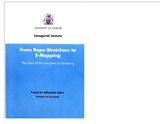Creation of a Web-based Database Application for Management of Compulsory Land Acquisition.case Study -a Section of the Nairobi -nakuru Highway (Uplands to Kimende)
Compulsory acquisition is power of the State to deprive or acquire any title or other interest in land for a public purpose subject to prompt payment of compensation (Land Act,2012).This project explored how geospatial technology can be used to assemble, manage and disseminate information required in the process of compulsory land acquisition. This involved use of Web GIS for creation of a web-based database application; this would assist in making the land acquisition process more effective, efficient and transparent.





